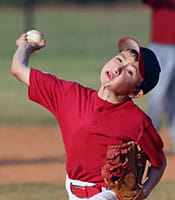What is Little League Shoulder?
 Little league shoulder is an overuse injury caused by stress to the arm bone (humerus) nearest to the shoulder. This stress causes widening of the growth plate, resulting in swelling and pain at the shoulder. It most commonly occurs in youth overhand pitchers between ages 11 and 16.
Little league shoulder is an overuse injury caused by stress to the arm bone (humerus) nearest to the shoulder. This stress causes widening of the growth plate, resulting in swelling and pain at the shoulder. It most commonly occurs in youth overhand pitchers between ages 11 and 16.
The following factors contribute to the injury:
- Repeated overhead throwing without proper rest
- Pitching and throwing with improper mechanics
- Lack of muscle strength, specifically in the shoulder and upper back
If untreated, the condition can worsen, leading to bone damage. There is a small chance for growth plate closure. Little league shoulder is often thought to mimic a stress fracture or a pediatric fracture called a Salter Harris Type 1 fracture. The good news is that little league shoulder will often heal completely with rest and a dedicated rehabilitation program.
How do I know if my child may have little league shoulder?
Symptoms of little league shoulder include:
- Pain in the shoulder with pitching or throwing
- Pain with the shoulder at rest or with lifting the arm
- Decreased throwing speed and / or accuracy
How is it diagnosed?
A doctor will complete a detailed physical exam and may order imaging tests. The diagnosis of little league shoulder and how severe it is can usually be made with X-ray imaging, which is done while your child is in the clinic. In certain cases, an MRI may be helpful.
Types of diagnostic tests:
- X-ray: the most common test for a shoulder injury. This test can show a widened or irregular growth plate.
- Magnetic Resonance Imaging (MRI): provides a more detailed image of both soft tissues and bone. It can look at tendons and ligaments, which cannot be seen with X-rays alone. It also provides a more detailed view of the growth plate.
How do I treat little league shoulder?
Once the diagnosis of little league shoulder is made, your doctor will decide the best possible treatment.
Conservative management:
- Rest – your doctor may suggest that your child avoid throwing activities for a period of time.
- Ice – this helps to decrease swelling and pain in the shoulder.
- Physical therapy – under the guidance of a certified physical therapist, your child will undergo a strengthening and stretching regimen that will focus on strengthening of the shoulder and arm muscles. Strength of the core, legs and hip are also emphasized to enhance stability and overall ability to throw.
- Video throwing analysis – at Cincinnati Children’s, we are able to perform two-dimensional video analysis of throwing motion. Trained therapists are able to break down the phases of throwing to look for deficiencies.
- Return-to-throwing program – once cleared to return to throwing, your child will undergo a progressive throwing program that slowly increases the forces and demands through the arm and shoulder, which are necessary for full return to competitive play.
Prevention
While no injury can be completely prevented, proper mechanics, rest and strength can reduce the risk of injury. USA baseball in partnership with major league baseball (MLB) have developed guidelines for young pitchers to help reduce the risk of injury.
Recommended pitch counts by age and associated rest periods:
| Age | Daily Max (Pitches in Game) |
0 Days Rest | 1 Days Rest | 2 Days Rest | 3 Days Rest | 4 Days Rest | 5 Days Rest |
| 7-8 | 50 | 1-20 | 21-35 | 36-50 | N/A | N/A | N/A |
| 9-10 | 75 | 1-20 | 21-35 | 36-50 | 51-65 | 66+ | N/A |
| 11-12 | 85 | 1-20 | 21-35 | 36-50 | 51-65 | 66+ | N/A |
| 13-14 | 95 | 1-20 | 21-35 | 36-50 | 51-65 | 66+ | N/A |
| 15-16 | 95 | 1-30 | 31-45 | 46-60 | 61-75 | 76+ | N/A |
| 17-18 | 105 | 1-30 | 31-45 | 46-60 | 61-80 | 81+ | N/A |
| 19-22 | 120 | 1-30 | 31-45 | 46-60 | 61-80 | 81-105 | 106+ |
(courtesy of pitch smart)
Parents also need to be aware of any reports of pain, fatigue or changes in throwing motions. These are often warning signs that, if ignored, may lead to more serious injury.



